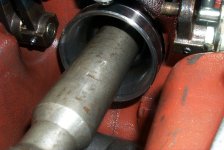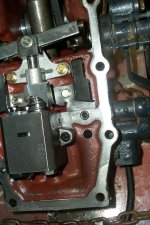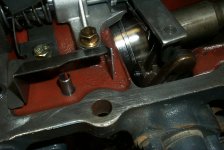"Unfortunately, as perverse as these systems are, you will probably never have any further personal use for the knowledge you gained in this process(Grin). However, you will be able to advise others."
Yep, this thought had already crossed my mind. And actually , I hope you are right. That means I never had to repair it again.
I suspect most folks would have just repaced the piston seals and put it back together. I have to try and figure out why this is happening and the cause of the problem more than the fix. I just can't fathom these piston seals wearing out so fast, and needed to solve it. Hopefully I have.
A couple of things: I checked my warranty paperwork, and at 155 hours, the dealership shows replacing all 4 piston rings, the 2 wear rinmgs, the lip seal and the backer ring. There was no mention of checking or cleaning any of the hydraulic valves. I now have 338 hours, and its shot again. I suspect that the pressure relief valve has always been sticking or stuck. These should last more than a little over 150 hours usage. If the mechanic at the dealership had inspected the relief valve, he might have corrected the problem.
Second, I have had more than one Branson mechanic advise me to be cautious when holding an implement in full lift. Some mentioned it could cause excess heat. I don't really understand that statement. What is the difference in holding an implement up with the piston halfway up the cylinder bore, or full out in max lift? Unless, something is happening at full lift that is not midway in the bore. That is what led me to really examine the piston relationship to the bore. In the one shot I posted earlier, you can see that it doesn't take much protrusion of the piston out the cylinder that the bottom wear ring is exposed and partially out of the bore. Some people have made posts that the heat gets so great it melts the backer ring, and probably collapses the lip seal, too. Why the heat? I haven't got a real good grip on it yet. Hopefully my attention to indexing marks and attempting to keep the piston fully inserted in the bore when in max lift will alleviate that issue. Time will tell.
The Branson manual says to transport implements in the lower position. Not sure if that caution was for road safety or equipment safety.
I read some other posts, that leaves me to ponder . Some have stated that the relief valve is ONLY in play when the lift is actually lifting, and when stationary, such as when you are driving down the road carrying your brush hog or ?? , its not into play. I have no way of proving or disproving that . I would need a real detailed fluid schematic to determine that , and of course I have none.
What drives me, is that why some older tractors have thousands of hours, and no apparent rear lift failures.
But, as you said, I hopefully will never have to call on this deep thinking issue again.

One thing I have already discovered, and will probably discover more to come, is that I keep my implements off the ground on concrete cinder blocks. Since I have restricted and changed the max lift height, I can barely clear the blocks to get them off, The most obvious solution to that is shorter blocks.

I did check my lift with the tiller on it to check leakdown. I shut the motor off, left it about 10 minutes, and noticed no leakdown. I could have left it longer but I had things to do.






